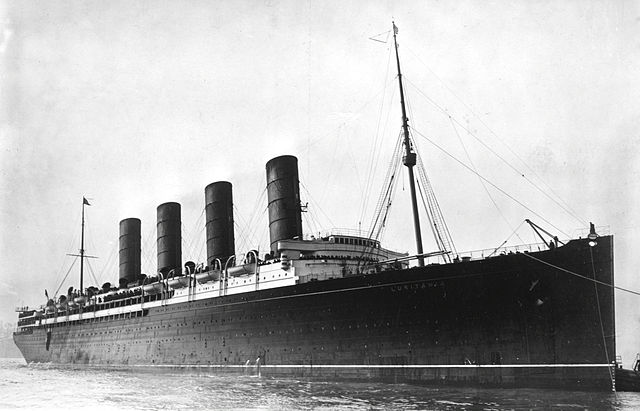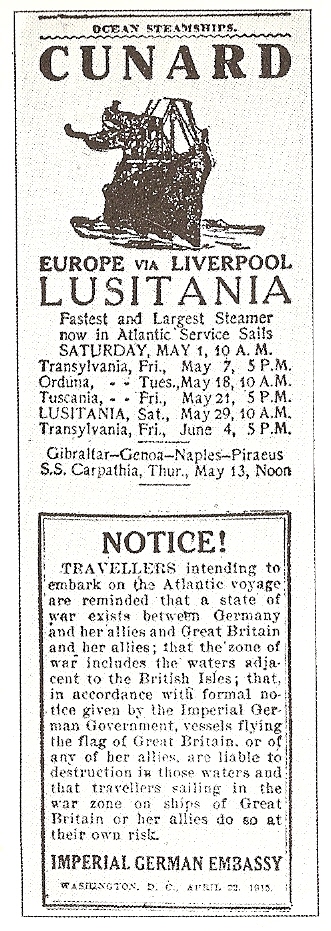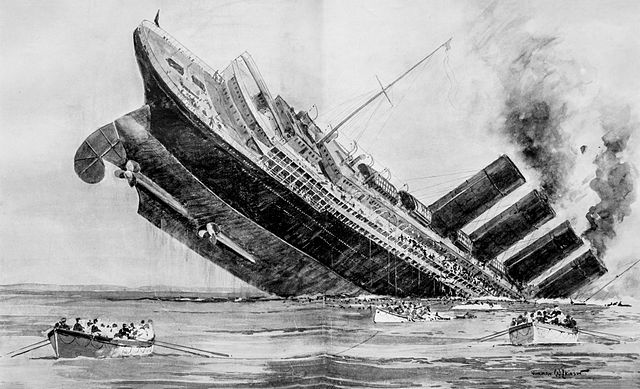
George Grantham Bain Collection, US Library of Congress, Digital Id cph.3g13287.
Public Domain
On 7 May 1915, the Cunard liner RMS Lusitania sailing from New York to Liverpool was torpedoed off Ireland and sank within 18 minutes. Of the 1,959 passengers and crew aboard, only 761 would survive. 128 of the passengers were American.
World War II had begun in 1914 between Britain, France, and Russia (including Belgium, Italy, Portugal, and Serbia) and Germany, Austria Hungary, and Turkey (then called Ottoman Empire). The United States, under President Woodrow Wilson, declared neutrality. Since the U.S. was a major trading partner with Britain, problems arose when Germany tried to quarantine the British Isles using mines. Several American ships ended up being damaged or sunk as a result. In February 1915, Germany declared unrestricted submarine warfare around British waters. This meant any ship entering these waters were subject to being attacked and sunk by German forces.
To make this very clear, the German embassy in Washington had advertisements run in New York newspapers in early May 1915 that Americans traveling on British or Allied ships in war zones did so at their own risk. In one case, the announcement was on the same page as advertisement of the Lusitania sailing from New York to Liverpool.

Author Unknown
Public Domain/Wikimedia Commons
The British Admiralty issued warnings, due to merchant ships being sunk off the south coast of Ireland, to ships to avoid the area or take evasive action (zigzagging was advised). The British objected by pointing out that threatening to torpedo all ships was wrong, whether announced in advance or not. During her construction, subsidized by the British government, it was done with the proviso she could be converted to an armed merchant cruiser.
A compartment was also installed to for the purposes of carrying arms and ammunition if it were needed. Gun mounts were installed for deck cannons, but they were not installed. At the time of her sinking, she was not operating in any official capacity as an armed merchant cruiser. The Germans suspected the ship was being used to transport munitions and her repainting to a grey color was an attempt to disguise her (it was, but to make it harder to spot from a periscope).
The Lusitania was one of the fastest liners on the Atlantic capable of 25 knots (29 mph) with many refinements. With lifts, the wireless telegraph, electric lights, and more passenger space (and more sumptuous accomodations), traveling on the Lusitania or her sister ships Aquitania and Maurentania was considered a good experience by seasoned travelers. The fact that she traveled so fast makes it likely it was simply being in the right place and the right time for the German U-boat. She could not possibly have caught the speedy vessel otherwise (there are arguments about what speed Lusitania was doing at this time off Ireland).

Public Domain(Wikimedia)
Captain William Turner did not use zigzagging while in the area (many argue that it does not really work). The commanding officer of the U-boat, Walther Schwieger, ordered one torpedo fired around 14:10 (2:10 pm). It struck the Lusitania on the starboard bow. A second explosion within the ship occurred and the ship began to founder starboard quickly. While the crew tried to launch the lifeboats, the severe list made it difficult and impossible in many cases. Only six of the forty-eight lifeboats would be launched. The ship sank in 18 minutes taking with her 1, 198 souls. Of the 764 that did survive (and that is a heroic tale of itself), three would die later from wounds sustained from the sinking. Though close to the coast, it would be some time before assistance arrived. Local fishing ships were the first to provide assistance, and later the naval patrol boat Heron. Other small ships provided assistance as well.
Aftermath
The sinking provoked international fury at Germany. Germany defended its actions saying the ship had been carrying contraband and was an armed auxiliary military cruiser. The reaction within Germany, Austria-Hungary and Turkey was criticism of the sinking. The German government tried to defend the sinking, even though she was not armed, by saying she was carrying contraband and they had warned this would happen. The official statements did not go over well in the United States or in Britain. Editorials in newspapers denounced what Germany had done calling for more to bring them to heel. It was hotly debated within the Wilson administration what to do. Wilson condemned what Germany had done but internally but William Jennings Bryan, the Secretary of State, argued for trying to convince both Britain and Germany to ratchet down some of the actions that had led to Lusitania sinking. Bryan was antiwar and like many did not want the U.S. getting involved in the European war.
Dead Wake: The Last Crossing of the Lusitania by Erik Larson
President Wilson would send three notes to Germany that made his position clear on the issue. First he said that Americans had the right to travel on merchant ships and for Germany to abandon submarine warfare on such vessels. Second, he rejected German arguments about Lusitania. This note caused Bryan to resign and was replaced by Robert Lansing. The third note was a warning that any subsequent sinkings would be “deliberately unfriendly.” That last one made it clear America’s position on the matter. While many wanted to stay out of the war, if the Germans did do it again they likely would find themselves at war with them.
The British government and press were not happy with Wilson over these notes. He was widely castigated and sneered. The reality was that American public opinion was not in favor of war. Wilson knew this and hoped Germany would stop attacking merchant vessels. There was some attempt within the German government to forbid action against neutral ships, which did curtail unrestricted submarine warfare for a while. British merchant ships were targeted, neutral ships treated differently (boarded and searched for war materials), and passenger ships left alone. But in 1917, Germany announced it would resume unrestricted submarine warfare. Wilson was furious and began preparations for war with Germany.
Shop For Lusitania books on Amazon
Sources:
—. “German Submarine Sinks Lusitania.” HISTORY, 6 May 2024, www.history.com/this-day-in-history/german-submarine-sinks-lusitania.
“The Lusitania Resource: Passengers and Crew, Facts & History.” The Lusitania Resource, 14 July 2023, www.rmslusitania.info.
